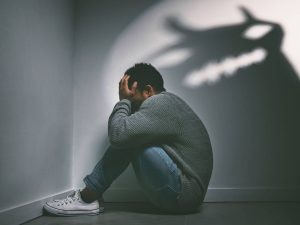Fear is a natural emotion that helps humans survive. It signals potential threats and activates protective mechanisms. However, when fear becomes excessive, irrational, and disproportionate to the actual danger, it transforms into a phobia. Phobias are mental disorders that profoundly impact a person’s life, limiting opportunities, disrupting social connections, and lowering quality of life. This text explores the causes of phobias, their classification, mechanisms of development, and methods of treatment, along with practical recommendations for living with them.
 Causes of Phobias
Causes of Phobias
Phobias can develop due to a combination of factors. Psychologists distinguish between biological, cognitive, and social causes.
Biological factors include heredity and genetic predisposition. Research shows that individuals whose close relatives suffered from anxiety disorders are at a higher risk of developing phobias. Genetic predisposition is linked to the functioning of neurotransmitters such as serotonin and dopamine, which regulate fear and anxiety responses.
Cognitive causes are related to personal experience and threat perception. If a person experiences a traumatic event—for example, drowning in childhood—they may develop a fear of water (aquaphobia). Cognitive models explain that the brain learns to associate an object or situation with intense fear, and these associations are reinforced through avoidance behaviors.
Social and cultural factors also play a role. Family, society, and media influence the formation of fears. For instance, children who often hear from parents that spiders are dangerous may develop arachnophobia even without direct traumatic experiences. Cultural narratives and stories about “scary” objects reinforce irrational fears.
Classification of Phobias
Phobias can be categorized, each type manifesting differently and affecting daily life in unique ways.
Specific phobias involve fear of particular objects or situations, such as heights (acrophobia), snakes (ophidiophobia), confined spaces (claustrophobia), or airplanes (aviophobia). These usually develop in childhood or adolescence.
Social phobias, or social anxiety, manifest as fear of situations where one may be judged or embarrassed, such as public speaking or interacting with strangers. These phobias often limit professional and personal growth.
Agoraphobia is the fear of open spaces or places where help may be difficult to obtain in case of a panic attack. People may avoid crowded streets, public transport, or shopping centers. Agoraphobia often accompanies panic disorders.
Complex and rare phobias include unusual fears, such as fear of numbers (arithmophobia), mirrors (catoptrophobia), or clowns (coulrophobia). Though uncommon, these phobias can significantly impact daily life.
| Phobia Category | Examples | Main Symptoms |
|---|---|---|
| Specific | Acrophobia, Arachnophobia | Panic, sweating, trembling |
| Social | Social Anxiety | Avoidance, shyness, embarrassment |
| Agoraphobia | Crowds, open spaces | Panic, fear of leaving home |
| Rare / Exotic | Arithmophobia, Catoptrophobia | Fear of unusual objects |
Mechanisms of Phobia Development
Phobias develop through the interaction of genetic, biological, and cognitive factors. One key mechanism is classical conditioning. When a person experiences a traumatic event, the brain associates the object or situation with a strong threat. For instance, a child who falls from a ladder may develop a fear of heights.
Another important mechanism is reinforcement through avoidance. People tend to avoid objects or situations that trigger fear, experiencing temporary relief. However, avoidance strengthens the phobia: the brain learns that the object is indeed dangerous, and anxiety intensifies.
Cognitive models explain that phobias are maintained by distorted risk assessment. Individuals with phobias often overestimate the danger of a situation and underestimate their ability to cope. For example, a person with arachnophobia may believe that even a small spider can threaten their life, though the real risk is minimal.
Neuroscientific studies show that the amygdala, a brain region responsible for fear responses, is hyperactive in people with phobias. This explains why physiological reactions—rapid heartbeat, sweating, and trembling—occur instantly when confronted with the feared object.
Treatment Methods and Practical Strategies
Phobias can be effectively treated using psychotherapy and behavioral approaches.
Cognitive-Behavioral Therapy (CBT) is the gold standard. It includes systematic desensitization, where patients gradually face the feared object in a safe environment. This allows the brain to reprogram its fear response. For instance, someone with fear of flying may first look at photos of airplanes, then visit an airport, and eventually take a short flight.
Exposure therapy involves intensive contact with the feared object. The patient is immersed in the situation until the physiological fear response decreases. This method requires professional guidance, especially for severe phobias.
Medication can help reduce extreme anxiety and panic attacks. Antidepressants or anxiolytics lower anxiety levels, enabling participation in psychotherapy.
Self-help and daily strategies include breathing exercises, meditation, physical activity, and keeping a fear journal. Recording anxiety-triggering situations helps analyze and gradually reduce the intensity of fear.
| Treatment Method | How It Works | Application / Examples |
|---|---|---|
| Cognitive-Behavioral Therapy | Reprogramming fear responses | Gradual exposure, cognitive restructuring |
| Exposure Therapy | Intensive immersion | Controlled contact with feared object |
| Medication | Reduces physiological anxiety | Antidepressants, anxiolytics |
| Self-Help | Daily techniques to reduce anxiety | Breathing, meditation, exercise |
For parents and educators, early identification of phobias in children and adolescents is crucial for preventing serious psychological consequences. Support, patience, and gradual exposure to the feared object help children build confidence and overcome anxiety.
Conclusion
Phobias are more than just fears; they are complex psychological conditions that can limit a person’s life. Understanding the causes, development mechanisms, and treatment options allows for effective management. A combination of psychotherapy, medication, and self-help strategies offers a high chance of reducing phobia intensity and improving quality of life.
Phobias also illustrate how the human psyche interacts with the world and how past experiences shape present behavior. Learning to manage and confront fears enables individuals to develop emotional resilience and self-control. Knowing that phobias are treatable and that one is not alone in their struggles empowers people to regain freedom in daily life.



